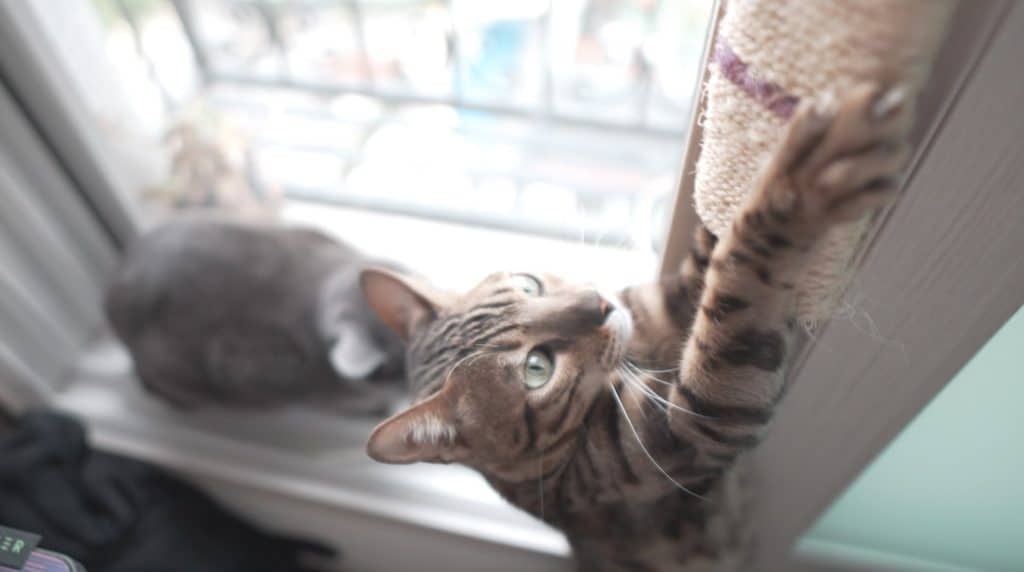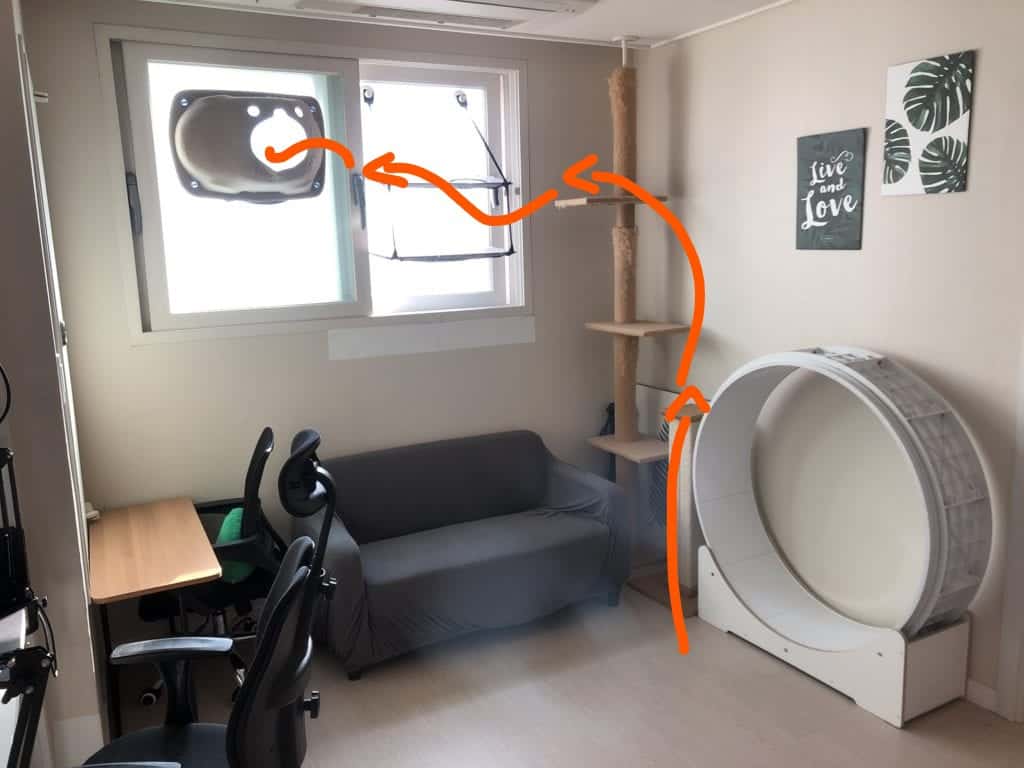Cats, like us humans, may get sluggish or lethargic if they don’t have enough activity or stimulation. The difference is that even though humans can still find entertainment through being inactive – cats cannot. Activity and exercise go hand in hand with your cat’s stimulation and engagement.

Finding that entertainment or engagement can be hard for your cats in small living spaces like apartments. The exercises/strategies are therefore based on years of experience with cats and living in small spaces; if a Bengal cat can happily live in my approximately 300 square foot apartment, any cat can!
Why Exercise Your Cats?
Your little indoor cats still retain many genes from big cats and their wild ancestors (your cat likely shares over 95% of their DNA with tigers). That means that house cats still have the instincts and behaviors that wild cats do. It is still essential for our pet cats to be able to exhibit these behaviors even when they aren’t needed in their surroundings in today’s indoor environment.
Thus, exercise, environmental engagement, and stimulation are important not only for our cat’s physical condition but also for their mental well-being. Having said that, anyone who has had experience with cats knows they will do whatever they want.
As a result, cat parents will need to set up strategies for cats to “exercise” and expend energy independently, rather than depend entirely on direct methods.
Four “Exercises” That Your Cat Actually Will Do in Apartments
Again, these are actions and activities that are designed to appeal to your cat’s inner hunter. A good “exercise” or activity for your cats will include one of the following behaviors:
- Exploring through climbing or burrowing.
- Depositing scent by either scratching or rubbing.
- Direct hunting simulation activities.
- Expending small spurts of energy efficiently.
Of course, almost every cat owner will know the typical answers to using interactive cat toys such as feather wands, lasers, or similar items to simulate hunting a rodent. So in this article, we’re going to focus on different ways to get our cats to exercise, move, and be more engaged in their apartment home without taking up too much space!
1. Ditch Cat “Condos”, Towers, and Trees: Use Cat Climbing Poles Instead
Many cat owners think that getting a cat tower or trees is the end-all, be-all of cat furniture, but the reality is, cats grow out of cat towers very quickly. Cat condos, towers, and trees are really just cat sleepers for adult cats (for my complete, curated list of the best cat furniture for apartments, check it here!). For kittens, cat towers are great, but as your cat grows up and gets bigger, cat towers become something akin to a tall bed.

Additionally, cat towers take up a lot of floor space, and the base of a cat tower has to be relatively wide to support all of the components of the cat tower. The only unfortunate thing is that these “features” or components don’t keep our cat’s attention for long.
Therefore, in small apartments, it’s better to go with a climbing specialized cat pole that is not only great for young kittens but will also be used as adults as well. Moreover, cat poles simply take up much less space than cat condos/towers/trees.

Climbing is an activity that all cats naturally know how to do. Cats climb to get away from predators or to survey their area for security or things to hunt. Climbing uses a lot of the cat’s muscles and thus, expends a lot of energy.
Additional Exercise & Climbing Tips
Some cats have their favorite items, such as a toy, bed, or blanket. Make a habit of placing or storing them in a high area that forces your cat to climb the cat pole to retrieve or access that item. First, it keeps cats off the floor (which is an essential tip for the safety of cats in apartments) and, at the same time, forces them to use their entire bodies to climb.
Snacks and cat-friendly scents such as catnip can be used too, as cats love to discover new scents and forage for food. It’s an excellent way to make them “work” to obtain their goodies! Your cat’s energy levels will spike for around 10 minutes with catnip, making it easier to initiate other activities with them!
2. Mealtimes into an Engaging Exercise: Use Cat Foraging/Puzzle Boards
One thing that indoor and apartment cats do every day, multiple times a day, is eating. Cats are highly food motivated because, again, in the wild, cats don’t know when their next hunt or meal will happen. Therefore, cats are almost always going to want to eat every time there’s food in front of them. And when cats eat, they eat very quickly. Of course, each cat home will have a different way to feed its feline companions.
This is why a very effective way to exercise a cat in an apartment is to use that food motivation to make them move. Cats will finish a meal within a couple of minutes if it’s in a bowl, but if it’s put into an activity or foraging board, they’ll not only take longer to eat – but they’ll move around and be much more engaged.

In the wild, cats are not only hunters but also foragers, and they’re very adept at getting food wherever it might be. And suppose you’re feeding your cats 2-4 times a day (it’s always recommended to have a feeding schedule instead of just free-feeding your cat). In that case, this is an incredibly effective way to exercise them physically and mentally throughout the day.
Additionally, feeding cats in the puzzle or activity/foraging boards allows you, as their owner, to create a stronger bond with your cats and be more aware of their conditions (eating too much or too little). Also, you’ll better know what the correct meal portioning is since humans “tend to underestimate calories and overestimate exercise.”
3. The Better Interactive Exercise: Cats Can Fetch Too!
Fetching also is an excellent way to exercise a cat in an apartment. Fishing/feather wands and similar interactive toys are great, but they can be difficult to use appropriately because of the limited space in apartments. However, with a good fetch toy, cats go wild as it bumps around the walls and items around the apartment. Smaller apartments enhance the effect as the toy can bounce around more often, and cats love the erratic motions.

Just make sure that the fetch toy is small enough for cats to grab with their mouths. An excellent way to check is if it’s approximately the size of the circle made when you touch your index finger with your thumb and like an 👌 gesture.
The fetch toy should also be extremely light. Light enough so that even the smallest of motions or bumps will send it off flying. Cats will almost naturally return the items for you to throw! It’s a much better activity for cat parents because we don’t have to move around too much. Almost all of my cats love to play fetch, especially my Bengal cat!
4. Cat Wheels For Cats With Zoomies
Dogs aren’t the only pets with the zoomies. Cats will sometimes have that burst of energy that makes them bounce off the walls (literally). Cat wheels allow your cats to sprint, run, or walk whenever they feel like it without hurting themselves or the damaging stuff around the apartment.
Admittedly, cat wheels are quite large (around 48-50 inches in diameters) and are quite an investment when compared to other cat products. However, for cat owners with super active cats – they can be an amazing tool for your cats to exercise and expend their energy. For a full guide on cat wheels, how to train a cat on a cat wheel, and the cat wheel I recommend, read my Complete Cat Wheel Guide!

It’s an item that gets repeated use from cats who are trained to use it, therefore, even though it’s quite large, it’s worth the cost in floor space and price. My cats in my apartment use the cat wheel for short spurts throughout the day but in total, they are likely on it for 1-3 hours! Which is a lot for something that is just passively there.
Conclusion: Exercising a Cat Needs a Holistic Mindset
Living things need variety and there’s no one method or exercise that completely satisfies your cat. While cats aren’t the most high-maintenance companions (Bengal cats are the exception), they do require some effort and thought to be put into their environment. This is especially true in small spaces such as an apartment.
For the full list of ways to entertain and stimulate your cats in an apartment, check out my article here! It even includes videos created by me to explain and visually show some examples.
